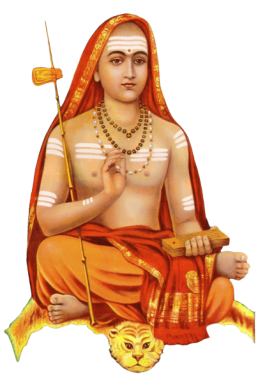यद्विज्ञाय नरो बन्धान्मुक्तः कैवल्यमश्नुते ॥ १२४ ॥
yadvijñāya naro bandhānmuktaḥ kaivalyamaśnute || 124 ||
अवस्थात्रयसाक्षी संपञ्चकोशविलक्षणः ॥ १२५ ॥
avasthātrayasākṣī saṃpañcakośavilakṣaṇaḥ || 125 ||
Vijnâna (knowledge) and Ananda (Bliss). The first two comprise this body of ours, the third and fourth make up the subtle body (Sukshma Sarira) and the last the causal body (Kârana Sarira). The Atman referred to in this Sloka is beyond them all. These Kosas will be dealt with later on in the book.
बुद्धितद्वृत्तिसद्भावमभावमहमित्ययम् ॥ १२६ ॥
buddhitadvṛttisadbhāvamabhāvamahamityayam || 126 ||
यश्चेतयति बुद्ध्यादि न तद्यं चेतयत्ययम् ॥ १२७ ॥
yaścetayati buddhyādi na tadyaṃ cetayatyayam || 127 ||
अभारूपमिदं सर्वं यं भान्त्यमनुभात्ययम् ॥ १२८ ॥
abhārūpamidaṃ sarvaṃ yaṃ bhāntyamanubhātyayam || 128 ||
Who shining etc.—A reproduction of the sense of the celebrated verse occurring in Katha Upanishad I I. V. 15, Mundaka II. ii. 10, and Swetaswatara vi. 14.
विषयेषु स्वकीयेषु वर्तन्ते प्रेरिता इव ॥ १२९ ॥
viṣayeṣu svakīyeṣu vartante preritā iva || 129 ||
वेद्यन्ते घटवद्येन नित्यबोधस्वरूपिणा ॥ १३0 ॥
vedyante ghaṭavadyena nityabodhasvarūpiṇā || 130 ||
निरन्तराखण्डसुखानुभूतिः ।
सदैकरूपः प्रतिबोधमात्रो
येनेषिता वागसवश्चरन्ति ॥ १३१ ॥
nirantarākhaṇḍasukhānubhūtiḥ |
sadaikarūpaḥ pratibodhamātro
yeneṣitā vāgasavaścaranti || 131 ||
Reflecting etc.—Compare Kena II. 12.
Commanded by whom .—See the opening Sloka of the same Upanishad and the reply given to it later on.
अव्याकृताकाश उशत्प्रकाशः ।
आकाश उच्चै रविवत्प्रकाशते
स्वतेजसा विश्वमिदं प्रकाशयन् ॥ १३२ ॥
avyākṛtākāśa uśatprakāśaḥ |
ākāśa uccai ravivatprakāśate
svatejasā viśvamidaṃ prakāśayan || 132 ||
Atman transcends all the three bodies—in fact the whole sphere of duality and materiality. The word ‘Akasa’ often occurs in the Sruti in the sense of Atman or Brahman. The Vedanta Sutras (I. i. 22) discuss this question and decide in favour of this meaning.
देहेन्द्रियप्राणकृतक्रियाणाम् ।
अयोऽग्निवत्ताननुवर्तमानो
न चेष्टते नो विकरोति किंचन ॥ १३३ ॥
dehendriyaprāṇakṛtakriyāṇām |
ayo’gnivattānanuvartamāno
na ceṣṭate no vikaroti kiṃcana || 133 ||
Compare Katha II. ii. 9.
न क्षीयते नो विकरोति नित्यः ।
विलीयमानेऽपि वपुष्यमुष्मिन्
न लीयते कुम्भ इवाम्बरं स्वयम् ॥ १३४ ॥
na kṣīyate no vikaroti nityaḥ |
vilīyamāne’pi vapuṣyamuṣmin
na līyate kumbha ivāmbaraṃ svayam || 134 ||
सदसदिदमशेषं भासयन्निर्विशेषः ।
विलसति परमात्मा जाग्रदादिष्ववस्था
स्वहमहमिति साक्षात्साक्षिरूपेण बुद्धेः ॥ १३५ ॥
sadasadidamaśeṣaṃ bhāsayannirviśeṣaḥ |
vilasati paramātmā jāgradādiṣvavasthā
svahamahamiti sākṣātsākṣirūpeṇa buddheḥ || 135 ||
Vivekachudamani – Introduction
1: Devoted Dedication
2: Glory of Spiritual Life
3: Unique Graces in Life
4-7: Miseries of The Unspiritual Man
8-13: Means of Wisdom
14-17: The Fit Student
18-30: The Four Qualifications
31: Bhakti – Firm and Deep
32-40: Courtesy of Approach and Questioning
41-47: Loving Advice of the Guru
48-49: Questions of the Disciple
50: Intelligent Disciple – Appreciated
51-55: Glory of Self-Effort
56-61: Knowledge of the Self-Its Beauty
62-66: Direct Experience – Liberation
67-71: Discussion on Questions Raised
72-75: Gross Body
76-82: Sense Objects a Trap – Man Bound
83-86: Fascination for Body Criticised
87-91: Gross Body Condemned
92: Organs of Perception and Action
93-94: Inner Instruments
95: The Five Pranas
96-101: Subtle Body – Effects
102: Functions of Prāna
103-105: Ego Discussed
106-107: Infinite Love – the Self
108-110: Māyā – Pointed Out
111-112: Rajoguņa – Nature and Effects
113-116: Tamoguņa – Nature and Effects
117-119: Sattvaguņa – Nature and Effects
120-121: The Causal Body – Its Nature
122-123: Not-Self – Description
124-135: The Self – Its Nature
136: Advice for Self-control
137-142: What is Bondage – The Reply
143-144: The Powers – Agitation and Veiling
145-146: Bondage in Action
147-153: Ātman and Anātman – Discrimination
Negation of the Kośas
154-164: – Annamaya kośa (Food sheath)
165-166: – Prņamaya kośa (Vital air sheath)
167-183: – Manomaya kosa (Mental sheath)
184-188: – Vijnanamaya kośa (Intellectual sheath)
189-191: Ātman – Unattached
192-193: What is Liberation? – Disciple
194-206: Self-Knowledge gives Liberation
207-210: Anandamaya kośa (Bliss sheath)
211: Ātman – Other than the Five Kośas
212: What is Ātman? – Disciple
213-225: Nature of the Self – Discussion
226-236: All Manifestation Absolute
237-240: Brahman – Its Nature
241-249: That Thou Art – Explanation
250-253: Attitude in Meditation
254-266: Aids to Meditation
267-276: Give up Vāsanās – the Method
277-292: End Superimposition – The Means
293-297: The Perceived I’ Factor – False
298-309: Condemnation of the Ego
310-319: Actions, Thoughts and Vāsanās – Renounce
320-329: Total Vigilance – Its Price
330-338: In the One, No Plurality
339-348: Spiritual Growth – the Secret
349-353: Cause-Effect – False
354-372: Samadhi – Its Nature
373-378: Fully Detached – Samadhi Easy
379-383: Meditation – the Technique
384-397: Continuous Attention to Self
398-406: No Diversity in Reality
407-413: Ātma-vicāra – Contemplation
414-418: Give up Perceptions
419-425: The Science of Reality – Its Benefits
426-445: Signs of a Realised Seer
446-464: Prārabdha for a Saint
465-471: There is No Plurality
472-479: Experience of Selfhood
480-520: Practice of Knowledge – Disciple
521-575: Final Words of Advice
576-578: Blessed Disciple Liberated
579-581: The Glory of the Textbook

Vivekachudamani – Verses 124-135 – Vivekachudamani Verses 124-135 – By Adi Sankaracharya – In Sanskrit with English Meaning, Transliteration, Translation, Commenary, Lyrics, Audio – Vivekachudamani-124-135
